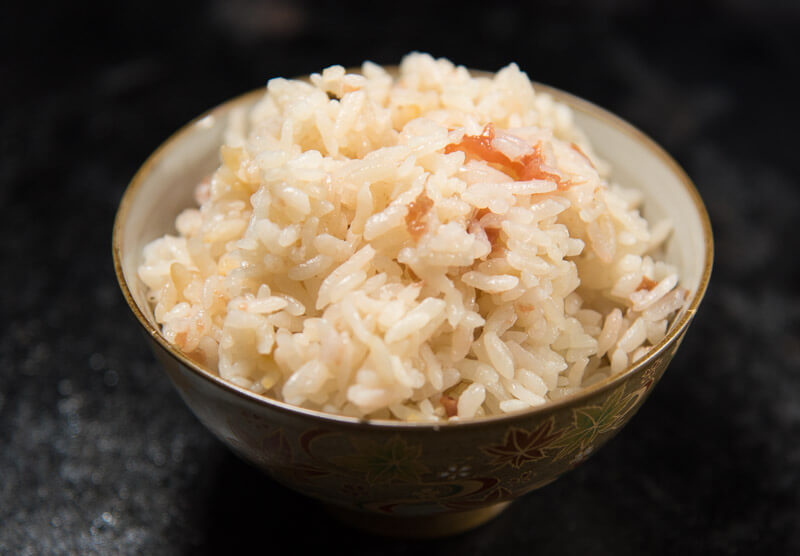There will come a time, when you’ve eaten too much white rice. Solution? Umeboshi Takikomi (Pickled Plum Cooked Rice). Umeboshi (pickled plum) adds a sublime tart and slightly sour flavor to each bite. And as the rice is coming straight out of the rice cooker, the aroma of pickled plum goes straight to your nose. In a good way. Serve this with any Japanese style meat or fish and you have a new found way to enjoy Japanese rice!

Pickled Plum Rice – Umeboshi Takekomi Gohan (梅干し炊き込みご飯)
This will be the first in a series of rice recipes.
This particular recipe is also referred to as takikomi gohan as we are cooking the rice and ingredients together. (Taki means to cook rice, and komi means together)
The overall concept will be the same for each.
You’ll start with white Japanese rice, rinse as usual.
Then you’ll add in whatever additional ingredients and cook them together with the rice.
For the liquid, as with many takikomi gohan recipes, we are substituting water with dashi stock.
You can use the dashi recipe I posted previously or packs or powder. Whatever is most easily accessible to you!
What is umeboshi ?
And as you may know, umeboshi are pickled Japanese plums that are often used in Japanese cuisine. There are specialty shops in Japan that sell this one thing – umeboshi and all different types and flavors.
Curious how umeboshi is made?
Umeboshi are made by pickling ume fruit (a type of plum) in salt and red shiso leaves. Here is a high level overview of the process for making umeboshi:
- Select ripe ume fruit: Choose ume fruit that are ripe but not overripe. They should be firm and have a green or yellow color.
- Wash and dry the ume fruit: Wash the ume fruit and pat them dry with a paper towel.
- Make a brine: In a large pot, combine water, salt, and red shiso leaves. The ratio of water to salt will depend on the recipe, but a general rule of thumb is to use 1 part salt to 10 parts water.
- Add the ume fruit to the brine: Place the ume fruit in the brine, making sure they are fully submerged.
- Weight the ume fruit down: To keep the ume fruit submerged in the brine, weight them down with a plate or other heavy object.
- Let the ume fruit pickle: Let the ume fruit pickle in the brine for at least one month, or up to six months. The longer the ume fruit pickle, the more sour and salty they will become.
- Remove the ume fruit from the brine: After the desired pickling time has passed, remove the ume fruit from the brine and pat them dry with a paper towel.
- Store the umeboshi: Umeboshi can be stored in the refrigerator in an airtight container for up to a year.
Note: The process for making umeboshi can vary depending on the recipe. This is just a general outline of the process.
What does umeboshi taste like?
Umeboshi have a unique sour, salty, and slightly sweet flavor and are often used to add flavor to rice and other dishes.
Umeboshi is naturally tart thanks to its citric acid content. Ume can contain up to three times as much citric acid as a lemon (yikes!)
The salt comes from the pickling process and sometimes sweetness is accentuated with honey.
For the umeboshi, I personally don’t like sweet (honey sweetened) so I always buy shiso (perilla) or salt marinated umeboshi.
While there are many other varities and preparations those are the most common you’ll find in the US.

Here are some tips for using umeboshi:
- Use umeboshi as a condiment: Umeboshi can be served as a condiment, either on their own or mixed with other ingredients. They are often served with rice and can be used to add flavor to sushi, onigiri (rice balls), and other dishes.
- Use umeboshi to add flavor to sauces: Umeboshi can be finely chopped and mixed into sauces to add flavor. They can be used in dressings, dips, and marinades.
- Use umeboshi to flavor soups and stews: Umeboshi can be added to soups and stews to add flavor. They can be placed whole in the pot or finely chopped and added towards the end of cooking.
- Use umeboshi as a natural breath freshener: Umeboshi are believed to have natural breath-freshening properties and are often eaten after a meal to freshen the breath. Try it on your partner 😉
- Store umeboshi in the refrigerator: Umeboshi can be stored in the refrigerator in an airtight container for up to a year.
Remember to use umeboshi sparingly, as they are very salty and can be overpowering if used in large amounts.
What do you eat umeboshi takikomigohan with?!
As you may know Japanese rice, or “gohan,” is a staple of Japanese cuisine and is often served as a side dish with a variety of main dishes. Here are some suggestions for what to serve with Japanese rice:
- Grilled or sautéed meat or fish: Japanese rice can be served with grilled or sautéed meat or fish, such as teriyaki chicken, beef stir-fry, or salmon.
- Noodles: Japanese rice can be served with noodles, such as udon, soba, or ramen. It may surprise you, but this is a common combo of carbs at teishoku (set meal restaurants in japan)
- Soups: Japanese rice can be served with soups, such as miso soup or tonjiru (pork and vegetable soup).
- Fried dishes: Japanese rice can be served with fried dishes, such as tonkatsu (breaded and fried pork cutlet) or tempura.
- Pickled vegetables: Japanese rice can be served with pickled vegetables, such as takuan (pickled yellow daikon) or umeboshi (pickled plums).
- Tofu dishes: Japanese rice can be served with tofu dishes, such as tofu stir-fry or tofu teriyaki.
I may be biased because I love umeboshi, but I think it goes well with almost any Japanese style cooked fish or meat!
Sometimes I just make white rice and eat a piece of umeboshi or rather add furikake or tsukudani (seasoned seaweed).
If you plan to go to japan anytime soon though, try to buy some umeboshi from a specialty shop on your next visit.
It might just change your life!

What do you think? Have you made takikomi gohan before?
Here is a short video showing how I make Umeboshi Takikomi gohan (Pickled plum rice)
Subscribe to my Youtube channel for Japanese cooking videos and more, one new video each Wednesday!
PrintUmeboshi Takikomi Gohan | Rice with Dashi and Pickled Plum 🍚
There will come a time, when you’ve eaten too much white rice. Solution? Umeboshi Takikomi (Pickled Plum Cooked Rice). Umeboshi (pickled plum) adds a sublime tart and slightly sour flavor to each bite. And as the rice is coming straight out of the rice cooker, the aroma of pickled plum goes straight to your nose. In a good way. Serve this with any Japanese style meat or fish and you have a new found way to enjoy Japanese rice!
- Prep Time: 5 minutes
- Cook Time: 50 minutes
- Total Time: 55 minutes
- Yield: 4 people 1x
- Category: side
- Cuisine: Japanese
Ingredients
- 2 cup Japanese white rice (I used the cup that came with rice maker so 1C= 200mL)
- 2 Tbsp mirin
- 1/2 tsp soy sauce
- cups dashi to bring liquid level to 2on rice maker (i used a dashi pack)
- 4 pieces umeboshi (marinated in shiso or honey if you prefer sweet)
- 1/2 tsp salt
Instructions
- Rinse rice until water runs clear and add to rice cooker pot.
- Add mirin, soy sauce, and enough dashi to bring the liquid level to just under the 2 cup marker
- Next add 4 pieces of umeboshi and 1/2 tsp salt.
- Cook per manufacturer instructions.
- Once complete, gently fold the rice and try to break off the flesh of umeboshi and mix in. At this point it would be a good idea to also remove the seeds (pits of the umeboshi!)
- Enjoy with fish or meat!
Notes
When I made this last, I ate it with aji nanbanzuke (vinegar soy sauce fish), however any fish or meat will work well!








Konnichiwa! (Hello!) I'm Pat Tokuyama, a Japanese tofu cookbook author, who travels for music, food, and adventure. If you like Japanese tea, checkout some of the newestorganic japanese tea, matcha bowls and noren and more!
** Curious about the Plant Based Japanese Cooking Club? ** Learn more here!